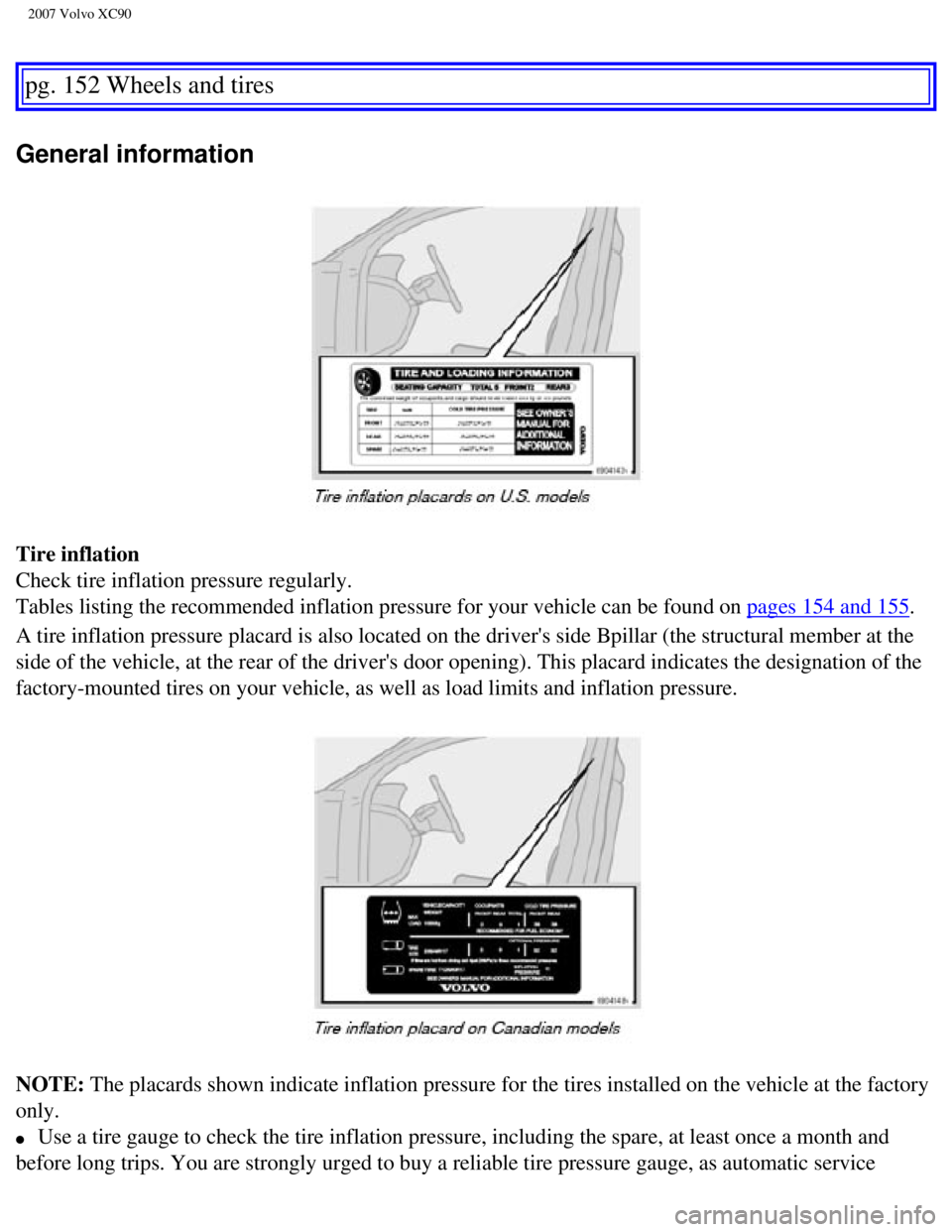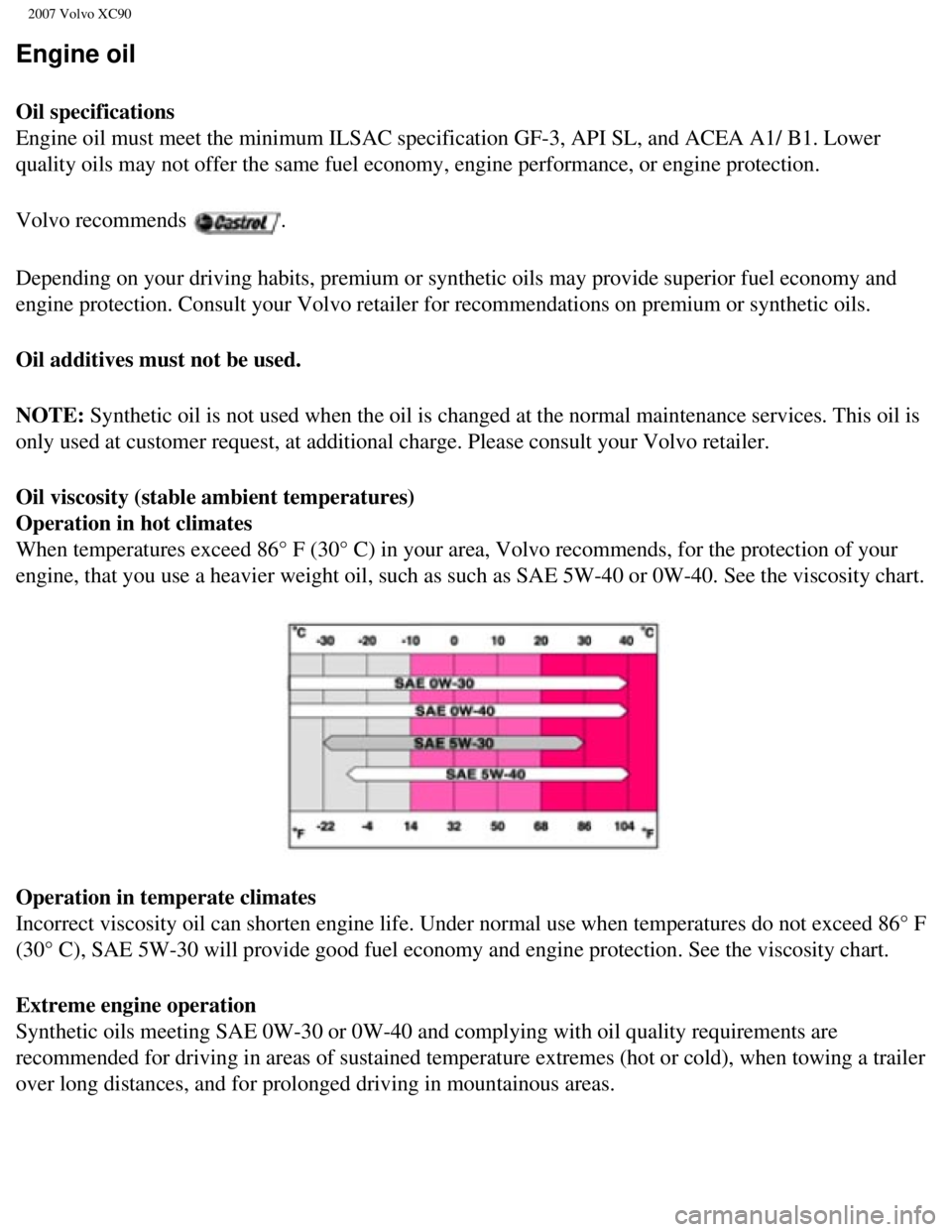2007 VOLVO XC90 service
[x] Cancel search: servicePage 160 of 268

2007 Volvo XC90
pg. 152 Wheels and tires
General information
Tire inflation
Check tire inflation pressure regularly.
Tables listing the recommended inflation pressure for your vehicle can b\
e found on
pages 154 and 155.
A tire inflation pressure placard is also located on the driver's side B\
pillar (the structural member at the
side of the vehicle, at the rear of the driver's door opening). This pl\
acard indicates the designation of the
factory-mounted tires on your vehicle, as well as load limits and inflat\
ion pressure.
NOTE: The placards shown indicate inflation pressure for the tires installed \
on the vehicle at the factory
only.
l Use a tire gauge to check the tire inflation pressure, including the spa\
re, at least once a month and
before long trips. You are strongly urged to buy a reliable tire pressur\
e gauge, as automatic service
file:///K|/ownersdocs/2007/2007_XC90/07xc90_07.htm (4 of 23)12/30/2006\
5:53:47 PM
Page 163 of 268

2007 Volvo XC90
pg. 155 Wheels and tires
Tire inflation pressure tables - Canadian models
The following tire pressures are recommended by Volvo for your vehicle. \
Refer to the tire inflation
placard for information specific to the tires installed on your vehicle \
at the factory.
Tire size Cold tire pressures
up to five persons psi (kPa) Optional pressure
up to three persons psi (kPa)
FrontRear Front Rear
225/70R16
235/65R17
235/60R18
255/50R19 39 (270
39 (270) 32 (220) 32 (220)
Temporary spare tire
T155/85R18 61 (420)
61 (420) 61 (420) 61 (420)
pg. 156 Wheels and tires
Tire Pressure Monitoring System (TPMS) - option
The tire pressure monitoring system uses sensors mounted in the tire val\
ves to check inflation pressure
levels. When the vehicle is moving at a speed of approximately 20 mph (\
30 km/h) or faster, these
sensors transmit inflation pressure data to a receiver located in the ve\
hicle.
USA - FCC ID: MRXTG315AM04
This device complies with part 15 of the FCC rules. Operation is subject\
to the following conditions:
(1) This device may not cause harmful interference, and (2) this dev\
ice must accept any interference
received, including interference that may cause undesired operation.
When low inflation pressure is detected, TPMS will light up the tire pre\
ssure warning light (
) (also
referred to as a telltale) in the instrument panel, and will display a \
message in the text window. The
wording of this message is determined by the degree of inflation pressur\
e loss.
NOTE: If a fault occurs in TPMS, the tire pressure warning light will flash f\
or approximately 1 minute
and TIRE PRESS SYST SERVICE REQUIRED will be displayed.
file:///K|/ownersdocs/2007/2007_XC90/07xc90_07.htm (7 of 23)12/30/2006\
5:53:47 PM
Page 165 of 268

2007 Volvo XC90
- Drive the vehicle for several minutes at a speed of 20 mph (30 km/h)\
or faster.
This will erase the warning text and the warning light will go out.
WARNING!
Incorrect inflation pressure could lead to tire failure, resulting in a \
loss of control of the
vehicle.
Changing wheels with TPMS
Please note the following when changing or replacing the factory install\
ed TPMS wheels/ tires on the
vehicle:
l Only the factory-mounted wheels are equipped with TPMS sensors in the va\
lves.
l If the vehicle is equipped with a temporary spare tire, this tire does n\
ot have a TPMS sensor.
l If wheels without TPMS sensors are mounted on the vehicle, TIRE PRESS SY\
ST SERVICE
REQUIRED will be displayed each time the vehicle is driven above 25 mph \
(40 km/h) for 10 minutes or
more.
l Once TPMS sensors are properly installed, the warning message should not\
reappear.
l Volvo recommends that TPMS sensors be fitted on all wheels used on the v\
ehicle. Volvo does not
recommend moving sensors back and forth between sets of wheels.
CAUTION!
When inflating tires with TPMS valves, press the pump's mouthpiece strai\
ght onto the valve to help
avoid bending or otherwise damaging the valve.
Adjusting (recalibrating) TPMS
1
TPMS can be adjusted, or recalibrated, in order to help adapt the system\
to different inflation pressures,
for example when transporting heavy loads. To do so:
- Switch off the engine.
- Inflate the tires to the desired pressure.
- Turn the ignition key to position I or II.
- Turn the thumbwheel on the left steering wheel lever until the text TI\
RE PRESSURE CALIBRATION
is displayed.
- Press in and hold the Reset button (see the illustration on
page 50) until TIRE PRESSURE
CALIBRATED is displayed. This completes the procedure.
NOTE: TPMS should be recalibrated each time tire inflation pressure is change\
d.
file:///K|/ownersdocs/2007/2007_XC90/07xc90_07.htm (9 of 23)12/30/2006\
5:53:47 PM
Page 187 of 268

2007 Volvo XC90
2 0 0 7
VOLVO XC90
Maintenance
pg. 179 Maintenance
Volvo service
180
Maintaining your car
181
Emission inspection
readiness
182
Working on your vehicle
183
Engine compartment
185
Engine oil
186
Fluids
188
Wiper blades
190
Battery
191
Replacing bulbs
194
Fuses
201
pg. 180 Maintenance
Volvo service
Maintenance service
Periodic maintenance will help keep your vehicle running well. Your Warr\
anty and Service Records
Information booklet provides a comprehensive maintenance schedule up to \
150,000 miles (240,000 km)
of vehicle service. This maintenance program contains inspections and se\
rvices necessary for the proper
function of your vehicle, and includes components that affect vehicle em\
issions. The maintenance
services contain several checks that require special instruments and too\
ls and therefore must be
performed by a qualified technician. Volvo advises you to follow the ser\
vice program outlined in this
booklet. To keep your Volvo in top condition, specify time-tested and pr\
oven Genuine Volvo Parts and
file:///K|/ownersdocs/2007/2007_XC90/07xc90_09.htm (1 of 37)12/30/2006\
5:53:50 PM
Page 188 of 268

2007 Volvo XC90
Accessories.
The Federal Clean Air Act - U.S.
The Federal Clean Air Act requires vehicle manufacturers to furnish writ\
ten instructions to the ultimate
purchaser to assure the proper servicing and function of the components \
that control emissions. These
services, which are listed in the "Warranty and Service Records Informat\
ion booklet," are not covered
by the warranty. You will be required to pay for labor and material used\
.
Maintenance services
Your Volvo passed several major inspections before it was delivered to y\
ou, in accordance with Volvo
specifications. The maintenance services outlined in the Warranty and Se\
rvice Records Information
booklet, many of which will positively affect your vehicle's emissions, \
should be performed as
indicated. It is recommended that receipts for vehicle emission services\
be retained in case questions
arise concerning maintenance. Inspection and service should also be perf\
ormed anytime a malfunction is
observed or suspected.
Vehicle Event Data (Black Box)
Your vehicle's driving and safety systems employ computers that monitor,\
and share with each other,
information about your vehicle's operation. One or more of these compute\
rs may store what they
monitor, either during normal vehicle operation or in a crash or near-cr\
ash event. Stored information
may be read and used by:
l Volvo Car Corporation
l service and repair facilities
l law enforcement or government agencies
l others who may assert a legal right to know, or who obtain your consent \
to know such information.
Applicable warranties
In accordance with applicable U.S. and Canadian regulations, the followi\
ng list of warranties is
provided.
l New Car Limited Warranty
l Parts and Accessories Limited Warranty
l Corrosion Protection Limited Warranty
l Seat Belt and Supplemental Restraint Systems Limited Warranty
l Emission Design and Defect Warranty
l Emission Performance Warranty
These are the Federal warranties; other warranties are provided as requi\
red by state/ provincial law.
Refer to your separate Warranty and Service Records Information booklet \
for detailed information
concerning each of the warranties.
file:///K|/ownersdocs/2007/2007_XC90/07xc90_09.htm (2 of 37)12/30/2006\
5:53:50 PM
Page 189 of 268

2007 Volvo XC90
pg. 181 Maintenance
Maintaining your car
Owner maintenance
Periodic maintenance requirements and intervals are described in your ve\
hicle's Warranty and Service
Records Information booklet.
The following points can be carried out between the normally scheduled m\
aintenance services.
Each time the vehicle is refueled:
l Check the engine oil level
l Clean the windshield, windshield wipers, headlights, and tail lights
Monthly:
l Check cold tire pressure in all tires. Inspect the tires for wear.
l Check that engine coolant and other fluid levels are between the indicat\
ed "min" and "max" markings.
l Clean interior glass surfaces with a glass cleaner and soft paper towels\
.
l Wipe driver information displays with a soft cloth.
l Visually inspect battery terminals for corrosion. Corrosion may indicate\
a loose terminal connector, or
a battery near the end of its useful service life. Consult your Volvo re\
tailer for additional information.
As needed:
l Wash the vehicle, including the undercarriage, to reduce wear that can b\
e caused by a buildup of dirt,
and corrosion that can be caused by salt residues.
l Clean leaves and twigs from air intake vents at the base of the windshie\
ld, and from other places
where they may collect.
NOTE: Complete service information for qualified technicians is available onl\
ine for purchase or
subscription at
www.volvotechinfo.com.
pg. 182 Maintenance
Emission inspection readiness
What is an Onboard Diagnostic System (OBD II)?
OBD II is part of your vehicle's computerized engine management system. \
It stores diagnostic
information about your vehicle's emission controls. It can light the Che\
ck Engine light (MIL) if it detects
an emission control "fault." A "fault" is a component or system that is \
not performing within an expected
range. A fault may be permanent or temporary. OBD II will store a messag\
e about any fault.
file:///K|/ownersdocs/2007/2007_XC90/07xc90_09.htm (3 of 37)12/30/2006\
5:53:50 PM
Page 190 of 268

2007 Volvo XC90
How do states use OBD II for emission inspections?
Many states connect a computer directly to a vehicle's OBD II system. Th\
e inspector can then read
"faults." In some states, this type of inspection has replaced the tailp\
ipe emission test.
How can my vehicle fail OBD II emission inspection?
Your vehicle can fail OBD II emission inspection for any of the followin\
g reasons.
l If your Check Engine (MIL) light is lit, your vehicle may fail inspect\
ion.
l If your vehicle's Check Engine light was lit, but went out without any a\
ction on your part, OBD II will
still have a recorded fault. Your vehicle may pass or fail, depending on\
the inspection practices in your
area.
l If you had recent service that required disconnecting the battery, OBD I\
I diagnostic information may
be incomplete and "not ready" for inspection. A vehicle that is not read\
y may fail inspection.
How can I prepare for my next OBD II emission inspection?
l If your Check Engine (MIL) light is lit - or was lit but went out with\
out service, have your vehicle
diagnosed and, if necessary, serviced by a qualified Volvo technician.
l If you recently had service for a lit Check Engine light, or if you had \
service that required
disconnecting the battery, a period of driving is necessary to bring the\
OBD II system to "ready" for
inspection. A half-hour trip of mixed stop-and-go/ highway driving is ty\
pically needed to allow OBD II
to reach readiness. Your Volvo retailer can provide you with more inform\
ation on planning a trip.
l Maintain your vehicle in accordance with your vehicle's maintenance sche\
dule.
pg. 183 Maintenance
Working on your vehicle
Note the following before you begin working on your vehicle:
Battery (see also
page 192 for more information on handling the battery)
l Ensure that the battery cables are correctly connected and tightened.
file:///K|/ownersdocs/2007/2007_XC90/07xc90_09.htm (4 of 37)12/30/2006\
5:53:50 PM
Page 194 of 268

2007 Volvo XC90
Engine oil
Oil specifications
Engine oil must meet the minimum ILSAC specification GF-3, API SL, and A\
CEA A1/ B1. Lower
quality oils may not offer the same fuel economy, engine performance, or\
engine protection.
Volvo recommends
.
Depending on your driving habits, premium or synthetic oils may provide \
superior fuel economy and
engine protection. Consult your Volvo retailer for recommendations on pr\
emium or synthetic oils.
Oil additives must not be used.
NOTE: Synthetic oil is not used when the oil is changed at the normal mainten\
ance services. This oil is
only used at customer request, at additional charge. Please consult your\
Volvo retailer.
Oil viscosity (stable ambient temperatures)
Operation in hot climates
When temperatures exceed 86° F (30° C) in your area, Volvo recom\
mends, for the protection of your
engine, that you use a heavier weight oil, such as such as SAE 5W-40 or \
0W-40. See the viscosity chart.
Operation in temperate climates
Incorrect viscosity oil can shorten engine life. Under normal use when t\
emperatures do not exceed 86° F
(30° C), SAE 5W-30 will provide good fuel economy and engine protec\
tion. See the viscosity chart.
Extreme engine operation
Synthetic oils meeting SAE 0W-30 or 0W-40 and complying with oil quality\
requirements are
recommended for driving in areas of sustained temperature extremes (hot\
or cold), when towing a trailer
over long distances, and for prolonged driving in mountainous areas.
file:///K|/ownersdocs/2007/2007_XC90/07xc90_09.htm (8 of 37)12/30/2006\
5:53:50 PM